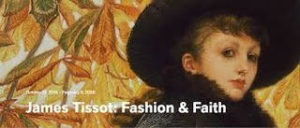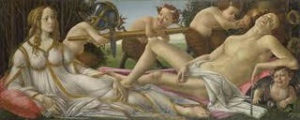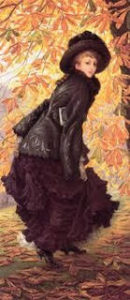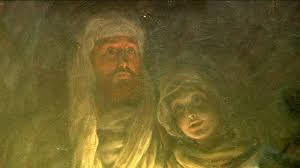
Figure 1. James Tissot: Fashion & Faith, Exhibition Poster. Legion of Honor Museum, San Francisco
Review by Beverly HELD Ph.D

Figure 2. James Tissot: l’ambigu moderne. Exhibition Poster. Musee d’Orsay, Paris
I love temporary art exhibition. I happily read all the wall text and descriptions as I take the journey that the curators have set out for me. If they have done their job well, if they tell their story in a compelling way, then while I am enjoying the exhibition, I am also thinking about how to share that story with you. And the more I write these reviews, the more unexpected synchronicities pop up. And so too with the exhibition that is the subject of today’s review, the exhibition at the Musee d’Orsay on the career of James Tissot. Yes he was French, yes James is English, we’ll get to that. Do you know Tissot ? I didn’t, not really, before I saw this exhibition, first in San Francisco at the Legion of Honor in January of this year. There, the exhibition was called “Fashion and Faith.’ My daughter loved it, I was more ech, but she has never met a luxurious fabric or representation thereof that she does not love. The exhibition now at the Musee d’Orsay has a different name, a different emphasis, more interesting (to me at least). The exhibition’s title in Paris is, ‘James Tissot L’ambigu moderne.’ The words fashion and faith are very straight forward, very American. Ambiguous modernity is more nuanced, more French. My computer program keeps wanting to change ambiguous to ambitious and in this instance, my computer’s correction is prescient because it was ambition that made Tissot’s modernity ambiguous. I enjoyed seeing these paintings a second time. Familiarity bred comfort not contempt. The exhibition closed in San Francisco in early February, scheduled to open in Paris on March 24. The paintings had already arrived, the galleries were being hung and then, in early March, everything came to a crashing halt. During the ensuing period of confinement, I wondered about the show. Would it come down without ever having been seen. We now know the happy answer to that. The paintings were waiting patiently for us all this time and now, masked and prudent, we make our way to the Musee D’Orsay. Although I must say that many people at the exhibition were not prudent. Yes everyone was masked but there was no social distancing at all. But I persisted dear reader for the pleasure of offering you this review.
Jacques Joseph Tissot was born in Nantes in 1836. Do you know Nantes ? It is a port town on the Loire and the capital of the Loire Atlantique. Sadly, like Bordeaux, it profited from the slave trade through the first quarter of the 19th century. I have been to Nantes a few times. Each time, no matter what time of day, I go to La Cigale, a gorgeous Belle Époque brasserie where I was introduced to the real, the authentic, buerre salé, the creamiest of butters slashed with lovely shards of the sweetest salt. You will not be surprised to know that immediately after enjoying my first taste of that salt, that butter, I insisted that my long suffering family join me in nearby Guerande to visit the salt museum. Worth the trip, maybe not, but it wasn’t far and sel de Guerande continues to be my sel of choice! Anyhow, Tissot was born there. His father was in the textile business, luxury textiles, étoffe, tissus, for elegant drapery, gorgeous dresses. His mother was a modiste, a chapellier, a milliner, in short, a hat maker. She had all that sumptuous fabric at hand, it must have been glorious. So, we have three threads that we will note in Tissot’s art - luxurious fabrics, gorgeous hats and images of the sea. His mother was also a devout Catholic. Under her supervision and years at a Jesuit boarding school, Tissot came to share her devotion to the Catholic Church. Tissot’s father wanted him to become a businessman. His mother was happy for him to be an artist. She prevailed. So two more strains will appear in his work, commercial from his father, piety from his mother.
In 1856, at the age of 20, Tissot was in Paris studying art with teachers who had studied with Jean-Auguste-Dominique Ingres, the master of sensuous feminine beauty and sensuous opulent fabric. Tissot would soon prove himself master of both. Amongst Tissot’s friends at the time were Whistler, Degas, Manet, household names to us now. In 1859, Tissot exhibited at the Paris Salon for the first time, five scenes from Goethe’s Faust. They were a success but he soon abandoned historicized paintings for the contemporary scene, just as Manet and Degas were doing. And like them, he developed a fascination for all things Japanese. And as knowledgeable about fabrics as he was, it will be no surprise that he was a Dandy, as some years later Felix Feneon was to be and Toulouse Lautrec was to document. In fact, Tissot was so enamored with all things English, he changed his name from Jacques to James!
Tissot’s friend Degas painted a portrait of him in 1867 and captured Tissot’s twin aspects - dandy and artist. (Figure 3) One contemporary described Tissot as having “a shock of jet-black hair, a drooping Mongolian mustache, an excellent tailor, and a small private fortune.” There is no denying his elegant, casual attire and nonchalant pose with his top hat and silk lined cape behind him all oozing Dandy. While he doesn’t have a brush or palette to define him as painter, he is surrounded by canvases, some hanging, some leaning, one with its back to the viewer. We see a Japanese painting at the top, a Manet to the side and a portrait then thought to be by Lucas Cranach in the center. A self portrait by Tissot from 1865 (Figure 4) shows him dabbling in the style that would eventually come to define the epoch but which Tissot did not pursue.

Figure 3. Edgar Degas. Portrait of Tissot, 1867

Figure 4. Tissot, Self Portrait, 1865
Tissot found financial success in Paris almost immediately. I will show you three examples among many from this period that are in this exhibition. The portrait of Miss LL from 1864 is one of them. (Figure 5) A seated brown haired beauty wearing a striking red bolero jacket with red pompoms marching with regularity along its edges. Did they escape from a bedspread somewhere? More pompoms, this time white, accentuate the drapes to our left. A single flower sits atop a stack of books. Who is this woman, we don’t know. What does she do, again, who knows. Maybe she is a bas bleu, ’bluestocking’ as women writers and intellectuals were called at the time. Tissot is definitely channeling Ingres here, especially in the woman’s pose and the mirror reflection behind her. (Figure 6)

Figure 5. Tissot, Mlle LL

Figure 6. Jean-Auguste-Dominique Ingres, Mme Senonnes, 1816
Another painting from this period is Marques and Marqueses of Miramon with their two children. (Figure 7) Posing in front of the family chateau seems quite reasonable to us today, but it just wasn’t done in France at the time. The countryside is there, wild but controlled, the Marques is relaxed, his son wears plaid tights I would just love to call my own. The Marqueses dress seems a tad too formal for the setting. I am not sure what to make of the size of that baby’s head. And what to make of the sliced pear on the salver between husband and wife, a sprig of red flowers, just beneath. Or the pile of stuff on the right, just behind the little boy. I am going to go with fecundity for the pear, abundance for the still life.

Figure 7. Tissot, Marques et Marqueses Miramon
Tissot painted another portrait of the Marqueses, celebrating all things Japanese but I would rather show you another painting from the 1860s which I find quite startling. A Caucasian woman in a kimono that has a mind of its own. (Figure 8) Her breasts are visible, as is a considerable amount of her well epilated crotch. That hat which reminds us of Tissot’s mother’s profession, that over the top hairdo. Who is she waiting for in this make believe Japanese bathhouse. Who knows. How over the top, how delicious it all is.

Figure 8. Tissot, The Japanese Bath
After the Franco-Prussian War and then the Paris Commune, Tissot decided that enough was enough and he left for London. He already had contacts there, he already had a gallery there. And of course, he had already Anglicized his name. Tissot found clients not amongst the aristocracy but amongst the industrialists, the arrivistes, the nouveau riches. John Ruskin was not impressed, he described Tissot’s paintings as 'mere painted photographs of vulgar society.' Be that as it may, by 1873, two years after his arrival, he could afford to purchase a house in St John's Wood where he lived for his entire stay in London.
In 1874, Degas wrote Tissot, encouraging him, cajoling him, to exhibit with him and their friends, the artists who would become known as the Impressionists. Tissot refused. He was doing well financially, people were commissioning portraits, buying paintings, he didn’t need to be associated with a group of painters who were pushing the boundaries but not finding any buyers. Tissot’s decision reminded me of two things. Achilles and George A Lucas. I remember when my son first saw the movie Troy with Brad Pitt as Achilles. He was 10 (my son, not Brad Pitt) and after we saw the movie, he just couldn’t stop talking about Achilles. Especially Achilles’ choice - to live a long and peaceful life, loved by his family but forgotten or to die young, a hero and remembered by posterity. Achilles chose the short life, obviously. Tissot chose to keep doing what he was doing which was what his clients wanted rather than experimenting with new techniques and new ways of seeing as his friends were doing. Rich and famous during his lifetime, mostly forgotten now. I wondered if George Lucas, the Baltimore art collector whose collection we discussed a few weeks ago had steered any of his clients Tissot’s way. Doesn’t look like it, which was surprising because Lucas had a knack for choosing safe painters. Maybe Tissot’s paintings were too expensive for Tissot’s Baltimore clients.
What did Tissot paint in London? So many paintings stand out from this period, let me show you three of them. The first is called The Gallery of the H.M.S. Calcutta. (Figure 9) A young man and two young women are standing on a ship’s deck. The young man, farthest from us, casually leans on the railing. The young woman closest to us, looks out to sea and uses a fan to hide her face from the young man. Wearing a white dress, she presents to us, the viewer, her back, and especially her backside, embellished with a large yellow bow. This painting reminds me of an exhibition that was at the Bourdelle Museum last year, ‘Fashion from the Back’. One section discussed how women’s dresses, like this one, fastened in back, made the wearer completely dependent upon someone to dress her, someone to undress her. She is a bonbon, here for our delectation and appreciation helpless without our help. Tissot intended a pun here, though perhaps only for himself and his French speaking friends. The word Calcutta can be understood, in French to mean ‘quel cul tu as’ or ‘what an ass you have’.

Figure 9. Tissot, HMS Calcutta
Another painting, The Shop Girl, is filled with gazers and the gazed upon. (Figure 10). We are in the picture, too, implied of course. Like Manet’s painting, Bar at the Folies Bergère, where we are the implied customer ordering a drink. (Figure 11) In Tissot’s painting, we are the implied customer being escorted out of a shop by an employee who opens the door for us with one hand and holds our purchase in another. To the left of the picture a young woman returns a box to its proper place. Holding it high above her head, she displays her lovely torso to the man on the other side of the window. The gaze of this top hatted man is direct, perhaps even insolent but Tissot manages to neuter him by lining his torso up with that of the mannequin in the shop window. The table in the immediate foreground is a riot of tumbling pink and rose ribbons dripping onto the floor. Tissot knew fabrics, knew ribbons, he had grown up with them.

Figure 10. Tissot, The Shop Girl, 1885

Figure 11. Edouard Manet, Bar at the Folies Bergère, 1882
Finally a third painting and then I promise, I will move on. It is a portrait of Frederick Burnaby, a captain in the Royal Horse Guards, a friend of the Prince of Wales. (Figure 12) Tissot shows him off duty, relaxing, talking, smoking. Beside him is his military cap, behind him, his full-dress uniform including cuirass and thigh-high black riding boots. The second I saw this painting, I thought of Botticelli’s Venus and Mars. (Figure 13) The God of War, in virtually the same pose as Burnaby, with his warrior’s helmet and breast plate abandoned. While Venus, cool and composed regards him, Mars sleeps a deep post-coital sleep, the satyrs around him can’t rouse him. Burnaby is not as burned out but his pose is as languid.

Figure 12. Tissot, Portrait of Frederick Burnaby

Figure 13. Botticelli. Venus and Mars, 1483
In the mid 1870s Tissot met Kathleen Newton, she would have been in her mid 20s, he was just shy of 40. (Figure 14) She was a beautiful Irish lass with two children. What ? Well, apparently at age 17, Kathleen had been shipped off to India to marry a much older man. And as these things go, the voyage was long, the flesh was willing and Kathleen arrived pregnant. Blame it on a member of the ship’s crew. Once her husband realized that the goods he had purchased were damaged, he promptly divorced her and sent her back to London. Somehow she managed to get pregnant a second time, by whom I do not known, maybe Tissot, probably not. Kathleen did though became Tissot’s model, muse, mistress. Since she was a divorcee, Tissot couldn’t marry her. But they lived together while her children bunked with her sister and children nearby. James and Kathleen saw the children often. Tissot painted them occasionally. Again I thought of George A Lucas who lived with a divorcee and her child for years. They never married either. Lucas and Tissot included their mistresses in their social life with their more bohemian friends, but not with their more staid clients. Oh well. Tissot painted Kathleen time and time again. Initially she is the flirtatious picture of rosy health. Gradually, she becomes weaker and sicker. She was suffering from consumption (tuberculosis). (Figure 15) Tissot chronicles her decline, depicting her ever paler. We are told that she was unable to watch his grief and so overdosed on laudanum (opium) and died in November 1882. Tissot sat by her coffin for four days. Before the week was out, Tissot has left London for good.

Figure 14. Tissot, Kathleen Newton

Figure 15. Tissot, Kathleen Newton
Now I am going to tell you something that seems so far fetched that I know dear reader if anyone else told you this, you might not believe it. Here goes. You remember what we discussed last week ? Spiritualism ? Well, guess who was able to contact his beloved Kathleen during a seance ? That’s right. Tissot even painted a portrait of her Spirit with his Medium.(Figure 16) And so at the age of 50, Tissot put aside his paintings of fashionable young women with their flirtatious, mildly erotic poses and started painting scenes from the Bible. He traveled to the Middle East three times between 1886 and 1996 to make studies of the landscape and the people. His series of 365 gouache illustrations of the life of Christ toured Paris, London and New York before the Brooklyn Museum purchased them. These images, the so-called Tissot Bible were a source for early film depictions of the life of Christ. This aspect of Tissot’s work gets a mention at the exhibition in Paris, much more space was devoted to it in San Francisco, hence the difference in title of the exhibition itself. One painting of Christ on the Cross depicts the scene from Christ’s perspective - how innovative is that ! (Figure 17) These biblical scenes made Tissot richer and more famous. Like Tissot’s entire career, he was completely in tune with the zeitgeist of his time and completely out of tune with his friends who were creating art that continues to resonate for us today. As the 18th century English artist Sir Joshua Reynolds wrote, I think it was him anyhow, he who seeks fame in the present risks oblivion in the future, or something like that. Good to think about. Definitely see this show, it is up through November.

Figure 16. Tissot, Kathleen Newton’s Spirit with Medium, 1885

Figure 17. Tissot, Crucifixion from Christ’s perspective on the Cross, 1894

2 comments
Stephanie Williams July 7, 2020
Excellent review on Tissot's life and work! It explains why he seems so conventional while the art world was exploding with the Impressionists.
Julia Frey September 22, 2020
What a wonderful aticle! Full of information, puns, sharp analyses of the paintimgs and witty sociological asides. Tho it did send me to the dictionary to look up the words "marques" and "marqueses". If the title wasn't just "James" Tissot's bad English, Beverly might want to hit the dictionary, too.